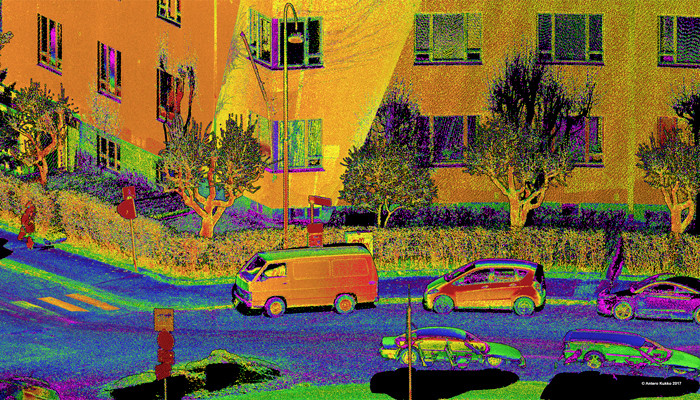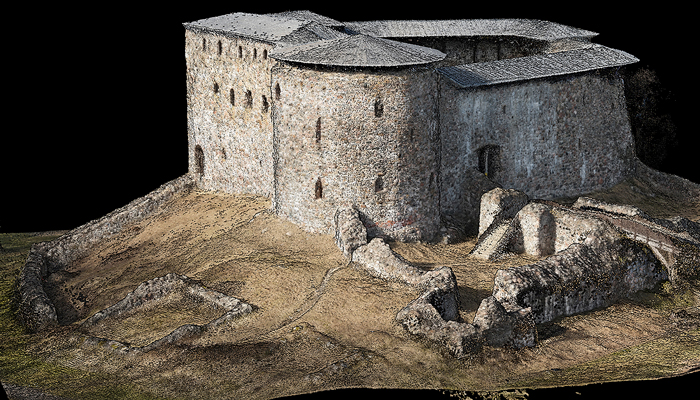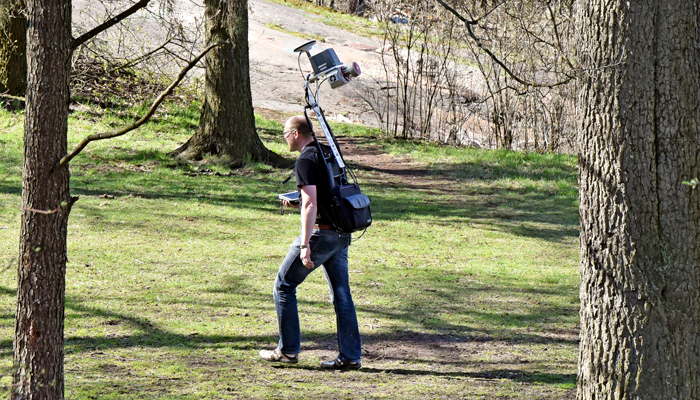Laser scanning the 3D world
Robotic cars, forest growth, virtual theatre, renovations... Laser scanning has a lot of applications, and new ones are being discovered all the time.

This is the basic idea: a laser beam bounces off the object being measured, and the time it takes the beam to travel back is used to measure the distance of the object. The cloud of measured points is used to build a precise three-dimensional model of a city, forest, house, human or, for example, a cow.
“At first, laser scanning was performed from aeroplanes, but today’s mobile scanners can be transported in a backpack or they might be a component of, for example, a robotic car’s eyes,” says Professor Hannu Hyyppä from the School of Engineering.
Hyyppä’s research group is linked to the Academy of Finland-funded Centre of Excellence in Laser Scanning Research (2014–19). Together with the Finnish Geospatial Research Institute, the group forms the Research Institute of Measuring and Modelling for the Built Environment, which is a world leader in mobile laser scanning.
“The demand for three-dimensional information is growing explosively. Our vision has laser scanning present everywhere, and affecting the lives of everyone in the information society of the 2020s.”
From museum objects to robotic buses
In mobile applications, the scanner is transported in a car, boat, robotic copter or backpack. A digital camera is a common optional extra used to assign colour values to the point cloud and give the object a more natural appearance. The development of GPS location systems and inertial measurement devices that measure an object’s position will lead to ever more precise 3D models.
The mobile scanners manufactured collaboratively at the Centre of Excellence in Laser Scanning Research are being used to perform measurements that are unique, even internationally.
“At first, we’d build our devices from scratch, but now we combine lasers, sensors, ATVs and other technology.”
In addition to more sophisticated devices, there’s need for algorithms that can sift out the desired information from the enormous volume of points.
In forestry, for example, researchers want to extract information concerning tree height, trunk thickness, branch volume and tree health. Using laser scanners to survey a forest can achieve accuracies ranging from two to five centimetres.
Indoors, mobile scanning is restricted by the weakness of satellite signals, so static indoor scanners are used to scan objects from several perspectives, thus avoiding blind spots. The modelling of indoor built areas has achieved accuracies of about one centimetre. The indoor scanners used to model small museum objects can achieve precisions of less than a millimetre.
“Measuring in itself is pretty easy, but the processing of billions of data points can take days,” Hyyppä points out.
Laser scanning is also used in the renovation construction of valuable locations. Precise dimensional drawings of the ceilings were made using laser scanning during the renovation of Aalto University’s new main building Dipoli, which was originally built in 1966, to ensure that they could be returned to their original appearance after dismantling and refurbishment.
Robotic bus scans its path
Laser scanning also aids self-driving cars. The most significant sensor in Google’s robotic car is the rooftop rotating laser scanner, which can generate a 360-degree image of the surroundings up to a distance of 200 metres.
The robot buses moving around Otaniemi as part of a demonstration trial use laser-based machine vision devices for navigation. Each minibus is equipped with a GNSS satnav receiver, cameras, 2D scanners on the vehicle’s corners and a rooftop laser scanner.
“A robotic bus needs a model of the surroundings to operate, and this model is updated constantly using laser scanning.”
The weather poses challenges for outdoor scanning, mostly in the form of scattering caused by moisture and snow. The mirrors of a scanner can also begin to frost and its electronics freeze when the temperature drops.
Even off-the-wall ideas might be considered
Multidisciplinarity is a full reality in the 27-strong research group led by Hannu Hyyppä: the team includes experts from land surveyors to virtual reality wizards and from transport engineers to cultural pundits.
“When you engage in creating something new, there’s isn’t always a ready template for who should do what. We operate beyond our own comfort zones. This is precisely how open-minded insights emerge,” says Science Producer Marika Ahlavuo.
The research group cooperates with universities, universities of applied sciences, upper secondary schools, businesses, cultural institutions and numerous other actors. It also has good relations with the film and game industries.

This 3D model of Raseborg Castle was made using a drone. Picture: Anttoni Jaakkola and Antero Kukko.
Old hospitals and a children’s art festival
3D scanning also has applications in art. Yle’s Swedish-language division and the Centre of Excellence in Laser Scanning Research produced an artwork for the Helsinki Festival in which Lapinlahti Hospital was laser scanned using a backpack scanner and photographed with a panoramic camera, creating a light and sound installation set in the period 1841–2006 and featuring imaginary ¬narratives from former patients including famed author Aleksis Kivi. A model of the hospital’s indoor space was input into the Unity game engine, enabling also remote users to explore the facility.
“Models of the built environment can be utilised in event production. The virtual world makes art independent of space and time,” says Marika Ahlavuo.
The Espoo Cultural Centre organises a children’s art festival called Art Tickling, which has showcased an exhibit of wonderful point cloud art as well as hologram presentations of laser-accumulated point cloud data on Finnish roads.
The Virtual Adventure in the World of Theatre project uses digital imaging, distance cameras, 360-degree video, augmented reality and laser scanners to build new sensational experiences.
“In an experiment being run at the City Theatre of Jyväskylä, viewers can explore the inside of the theatre in virtual reality, getting to see how the illusion of the performance and its scenic elements are created, and what kinds of activities take place at the theatre beyond the stage,” Ahlavuo says.
From cows to kitchen renovations
The research group is constantly looking at new applications for laser scanning. In the Pig Data project, 3D -scanning is brought to cowsheds and piggeries. Researchers will study how animal development and welfare could be ¬monitored with the aid of 3D models.
Urban planners are considering if the 3D modelling of green area construction could aid in determining the value of houses.
The Academy of Finland-funded COMBAT point cloud project aims to create a 3D model covering all of Finland that would digitise the nation’s forests, rivers, cities, electricity lines and traffic environments.
“Among other things, we will examine how the data on road environments that cars will soon be collecting could be utilised for road maintenance and improving safety,” Hyyppä says.
It is thought that laser scanning will be a feature of mobile phones in a few years time. Hyyppä envisions a kitchen renovation of the future:
“I’ll laser scan pictures of the kitchen cabinets with my phone or pad, process them into a model and then send it to cabinet makers so they can bid for the job.”
“Laser scanning is coming into cars, consumer devices, smart garments – everywhere. In cartoons, inventors are sometimes portrayed with propellers on their heads. These could well be replaced by laser scanners,” Hyyppä chuckles.

Backpack scanning in the terrain. Photo: Hannu Hyyppä and Antero Kukko.
- A million rays per second
- Laser scanning is a measuring technique in which laser beams are used to make precise three-dimensional model without having to physically touch the object being measured. Scanning is based on laser pulses that refract from the object back to the scanner. The distance is then calculated from, for example, the time it takes the rays to bounce back.
- A laser scanner will send up to a million rays per second in different directions. When the precise location and position of the scanner is known, distances can be converted into three-dimensional xyz coordinates for each individual point. The point cloud thus created can consist of up to billions of discrete points. Three-dimensional surfaces are identified and modelled out of the point clouds with the aid of computation.
- The measuring technique, which was originally developed for military use, came to Finland in the 1990s in the form of forest surveys. In the 2000s, the sector’s breathtaking development has been aided by the evolution of GPS location and inertial measurement technology.
- The range of application areas is growing rapidly. In Finland, laser scanning has today expanded from forest surveying into the lives of everybody in the shape of, for example, the maps generated by ¬Google’s Street View vehicles.


